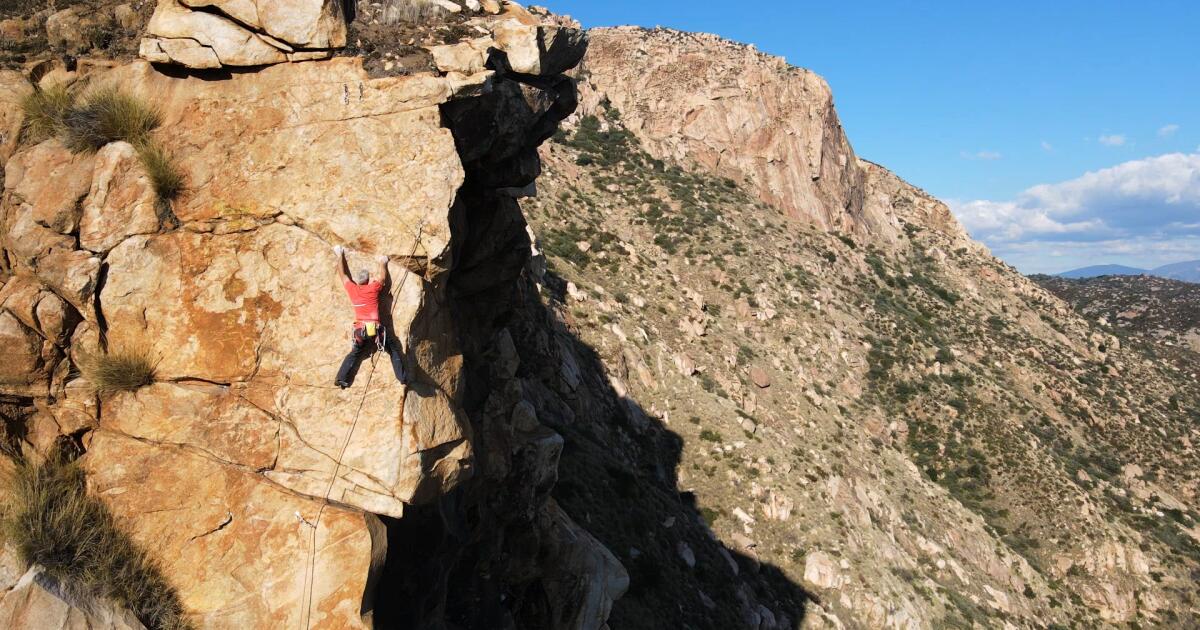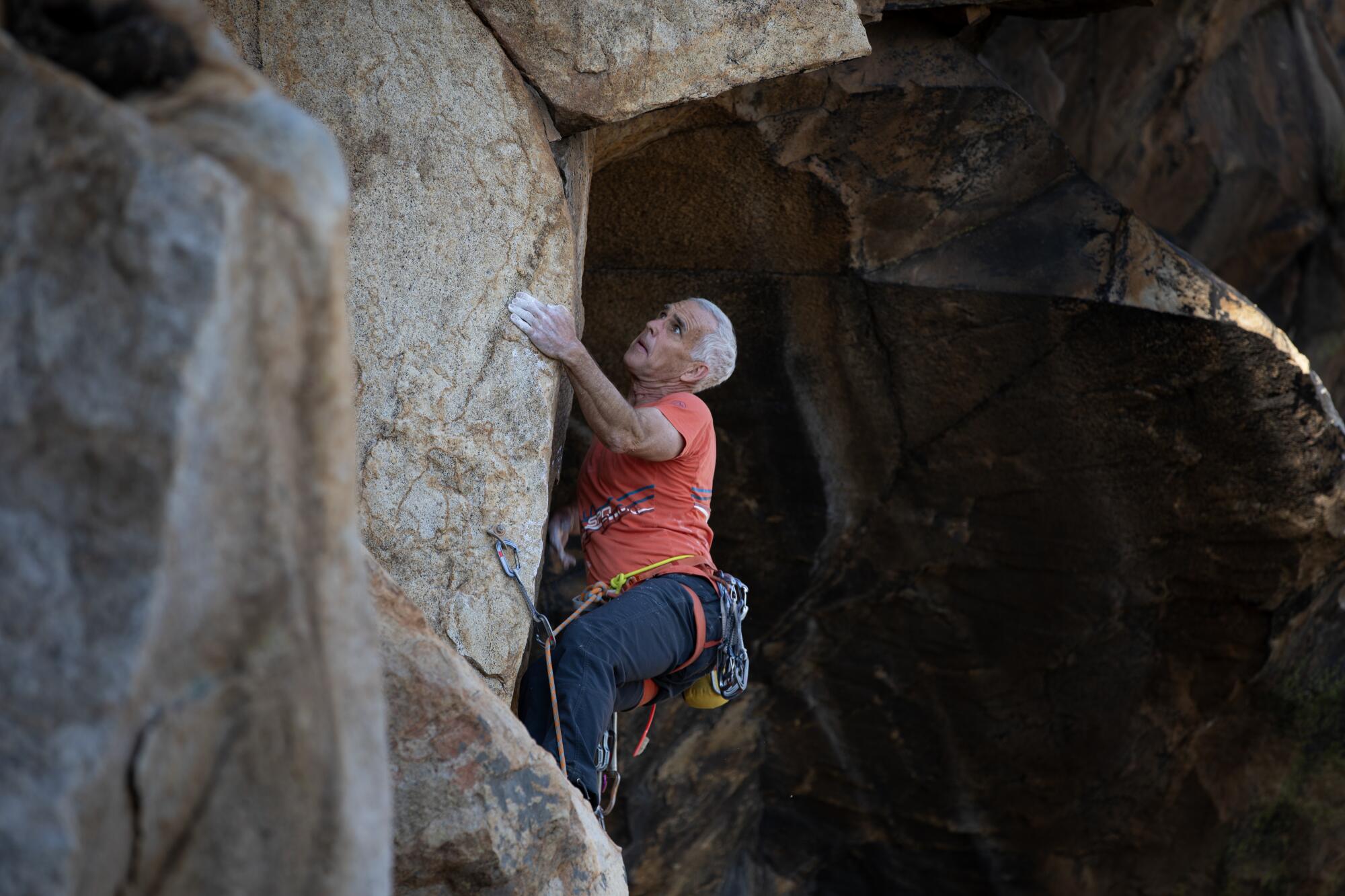
The November sun shines brightly on Randy Leavitt as he carefully places his hand on the face of a rock at El Cajon Mountain. He’s rock climbing nearly 100 feet up the wall and, in the silence, all one can hear is the sound of his steady breathing.
From the ground, it looks like he’s climbing to the sky.
“Slack,” Leavitt calls down to his belay partner, Chris Hubbard, as he pulls the climbing rope up from below and clips it into a quickdraw, a piece of equipment that attaches to an anchor on the wall and is used to secure a climber to the rock.
“Climbing,” he says once the rope is fastened.
“All right, buddy,” Hubbard yells back. “I gotcha.”
Leavitt knows what he’s doing. He’s a professional rock climber who has climbed and developed many of the most difficult routes in San Diego County and taken his skills across the western U.S. to places like Yosemite National Park, Joshua Tree and Arizona. He started the sport in 1975 as a teenager.
Now, at 63 years old, not a lot has changed for Leavitt.
Decades later, he’s one of a handful of highly skilled locals who are still climbing in San Diego and beyond. Leavitt, Hubbard and other fellow climbers, many of whom are now over the age of 60, helped develop rock climbing in San Diego during the 1980s, 1990s and 2000s and are still finding new places to climb here.
“I like exploring. If I was back in the wagon train days, I’d probably be coming across the Grand Canyon for the first time,” Leavitt says. “So this is our own little version of it, to feel like we’ve found something and experience it for the first time.”

Randy Leavitt, 63, climbs the Wobbler which is a part of the Chocolate Wall, a subsection of Mountaineers Wall, on El Cajon Mountain on Friday, Nov. 17, 2023 in San Diego, California. Leavitt has been climbing since the 70s.
(Ana Ramirez / The San Diego Union-Tribune)
Today, he’s climbing the Wobbler, a route where he and Hubbard achieved the first ascent in 2010, though this is the first time he’s climbed it since then. The dark granite wall is located on the southern side of El Cajon Mountain, a prominent peak in East County.
It’s rated as 5.12a on the Yosemite Decimal System, a metric used to rate the difficulty of climbing routes on a scale from 5.1 to 5.15.
Leavitt and Hubbard have been climbing and discovering new routes together since 1995, and they have a familiarity and trust between them while climbing to show for it. Both use climbing gyms but prefer to be outdoors, where it all started.
“I’m an old guy now,” the 62-year-old Hubbard said. “Being out on the rocks is my area where I can still play the game at a good level where I’m happy, hanging out with everyone and having a good time.”
Hubbard calls their pioneering role in local climbing history “generational luck.”
He and Leavitt, along with climbers Gary Anderson and Brian Spiewak, were some of the first to find viable routes on El Cajon Mountain starting around the early 2000s, including this area called the Chocolate Wall. Now, there are hundreds of routes along the mountain’s cliffs that they and other climbers developed.

Chris Hubbard, 62, climbs Coco a go go which is a part of the Chocolate Wall, a subsection of Mountaineers Wall, on El Cajon Mountain on Friday, Nov. 17, 2023 in San Diego, California. Coco a go go is a 90-foot climb and ranked a 5.10c for level of difficulty.
(Ana Ramirez / The San Diego Union-Tribune)
The evolution of San Diego’s rock climbing
Organized rock climbing in San Diego began around the 1950s, soon after the launch of the Sierra Club’s San Diego chapter in 1948. The group would host outdoor events and teach people how to climb, camp and backpack.
Through the 1960s and ‘70s, rock climbing in the U.S. grew in popularity. In San Diego, climbers gravitated toward places like Mission Gorge, Mount Woodson and Santee Boulders.
Household names in the San Diego climbing world included Keith Brueckner, John Bachar, Tom and Elke Lindner and a group called the Poway Mountain Boys. But it’s impossible to list all the great climbers who came out of San Diego and have contributed to its climbing scene over the last 70 years; there are too many.
The late 1980s and ‘90s brought “a new attitude about exploration (that) yielded some of the best routes” in the county, David Kennedy wrote in his “San Diego County Climbing Guide” with Hubbard, first published in 1999 and updated in 2007.
Around this time, Hubbard said, more people became local climbers. Leavitt was one of them.
Leavitt moved from his home in Los Angeles to San Diego in 1981 to finish school at UC San Diego, but earlier, in the 1970s, he started climbing at Mount Woodson, where the climbing was similar to that of Yosemite and Joshua Tree. He recalls that many transplant climbers like him would practice here before heading to the bigger walls in those locations.

Randy Leavitt, 63, climbs Chocolate Cake which is a part of the Chocolate Wall, a subsection of Mountaineers Wall on El Cajon Mountain on Friday, Nov. 17, 2023 in San Diego, California. Leavitt has been climbing since the 70s. Leavitt was the first person reported to climb El Capitan in Yosemite National Park and then BASE jump off it. Chocolate Cake is a 50-foot climb and ranked a 5.10a for level of difficulty.
(Ana Ramirez / The San Diego Union-Tribune)
Over the years, Leavitt set himself apart, developing impressive routes across the country, including one well-known route called “Jumbo Love” on Clark Mountain in the Mojave Desert, and a climbing technique that is named after him called Levittation. Along with rock climbing, Leavitt was also the first person reported to climb El Capitan in Yosemite and BASE jumping off the top in 1980.
“You were the king of El Cap,” Hubbard says to Leavitt as they sit below the Chocolate Wall.
After a pause, Leavitt says with a smile: “I was the prince. I was in the royal family.”
To be anywhere near the top of the rock climbing kingdom, a climber must be extremely talented — and willing to take the risks that come with the sport. Rock climbing can be highly dangerous — sometimes fatal — especially when the proper safety protocols are not followed.
But these climbers —now in their 60s and 70s — aren’t foolish. Perhaps unlike younger climbers, they are all too aware of the risks, having seen fellow climbers suffer injuries over the years.
At El Cajon Mountain, Leavitt and Hubbard follow strict safety checks before climbing.

Chris Hubbard, 62, belays as Randy Leavitt climbs a portion of the Chocolate Wall, a subsection of Mountaineers Wall, on El Cajon Mountain on Friday, Nov. 17, 2023 in San Diego, California. Leavitt has been climbing since the 70s and Hubbard since the 90s. Leavitt was the first person to climb El Capitan in Yosemite National Park and then BASE jump off it.
(Ana Ramirez / The San Diego Union-Tribune)
Rock climbing is more dangerous than many other sports, and most styles also require a certain level of human-made handiwork before someone can get on the wall. This starts with finding good rock, which often includes hiking to scope out an area. Then, to develop a route, climbers must visualize a path up a rock face before adding fixed protection, like bolts and anchors.
“It’s kind of an artistic interpretation of the terrain,” Leavitt says of the process.
It wasn’t easy to do in San Diego. For years, Leavitt and other climbers were deterred by the landscape. Getting to climbing rocks required bushwhacking through dense brush, and some smaller rocks were hard to spot, hidden behind the plant life.
“San Diego was sort of a backwater in a way,” Hubbard said. “A lot of people wanted to do something like rock climbing, but it didn’t appear in San Diego as something that you could easily figure out. The rocks don’t jump out at you.”
Many climbing areas are also located deeper in the San Diego backcountry, so climbers must hike one to two hours to get there.
The long hike to the Chocolate Wall follows a steep trail up the side of the mountain, surrounded primarily by invasive pampas grass. There’s no shade, and despite it being 8:30 a.m. at the start of the hike, the sun beat down ruthlessly.
Leavitt and Hubbard, both carrying backpacks weighing around 25 pounds, didn’t seem too phased. For them, the hike is worth it for the climbing that awaits.

Randy Leavitt, 63, left, and Chris Hubbard, 62, hike an hour and half up El Cajon Mountain to climb the Chocolate Wall, a subsection of Mountaineers Wall, on Friday, Nov. 17, 2023 in San Diego, California.
(Ana Ramirez / The San Diego Union-Tribune)
The same goes for Gary Anderson, who helped discover this climbing area with Leavitt, Hubbard and Brian Spiewak, who is now in his 40s. Anderson, at 70 years old, is the oldest member of the squad and says that getting to the wall itself is part of the adventure.
“The hike alone will keep you in shape,” he says. “It’s good exercise.”
Still climbing after all these years
Though today only Leavitt and Hubbard are climbing at El Cajon Mountain, the group of four still climbs together regularly.
It’s clear that they enjoy each other’s company, which is important when they’re putting in 12-hour climbing days.

Randy Leavitt, 63, left, and Chris Hubbard, 62, take a break before climbing Chocolate Wall, a subsection of Mountaineers Wall, on El Cajon Mountain on Friday, Nov. 17, 2023 in San Diego, California.
(Ana Ramirez / The San Diego Union-Tribune)
Hubbard and Leavitt talk about the old days, but the reminiscing doesn’t seem to come from a place of wistfulness — likely because they’re still doing the things they love.
In addition to climbing, they spend a lot of time discovering new places to climb, and they aren’t alone. Several other “first ascensionists” of San Diego — a person who is the first to develop or climb a route — are still at it as well.
“It’s the adventure of it and going new places,” Anderson says. “It’s a pretty exhilarating sport.”
Jeff Brown, one of the founding members of the Allied Climbers of San Diego, a group that works to protect climbing access in the county, is 63 years old and still seeking out new spots.
He “was always interested in what was around the next corner” and helped develop places like Corte Madera in East County and Eagle Peak in the Cleveland National Forest.
And 67-year-old David Kennedy, who wrote the “San Diego County Climbing Guide,” took 12 years off from climbing, but says he is returning to it now. He, like the others, discovered climbing areas and set new routes in the 1990s, including a place called the Poway Crags.
Now he often climbs at Mission Gorge, where he recently added two new routes and was the first to climb them.
“When I’m doing a first ascent, I’m motivated to climb at my very best. You get the first ascent fever,” Kennedy said. “So I decided to return to that to help keep me motivated and give me little projects to obsess over.”
Over the years, Leavitt developed a reputation for setting some of the most difficult and beloved routes in San Diego County, including at Mount Woodson, Eagle Peak and El Cajon Mountain. One of the routes on El Cajon Mountain, called “Pockets of Resistance,” was featured on the cover of Rock and Ice magazine in 2005.
“He’s like the godfather,” Anderson said with a laugh.

Randy Leavitt, 63, climbs the Wobbler which is a part of the Chocolate Wall, a subsection of Mountaineers Wall, on El Cajon Mountain on Friday, Nov. 17, 2023 in San Diego, California. Leavitt has been climbing since the 70s.
(Ana Ramirez / The San Diego Union-Tribune)
Each of these climbers is still climbing at or near the level they did when they were 30 years old, but it’s not necessarily by luck.
Neither Leavitt or Hubbard drink alcohol (Hubbard gave it up at the age of 35), and Hubbard stays away from sugar and coffee, opting instead for an afternoon black tea. Leavitt climbs about three times a week, including at a climbing gym, and otherwise stays active through surfing and yard work.
Anderson eats a vegan diet, which he says has kept him healthy, and regularly works out by lifting weights and riding a bicycle.
But they can also use rock climbing as a gauge of their health and skill. While they might change, the rock stays the same.
“You can assess your fitness level over the years when you get back on climbs,” Anderson said. “So it’s like a barometer of where you’re at physically.”
Sometimes, the years do show: Hubbard has a shake in his left hand before he warms up on the wall, which he says is “so bogus.”
Back at El Cajon Mountain, Hubbard and Leavitt organize their gear before heading home. The sun is giving way to clouds and there’s finally a breeze, some much needed relief after the heat of the day.
Rock climbing on El Cajon Mountain wasn’t established in earnest until the early 2000s, in large part due to the thick vegetation. The climbers say that the 2003 Cedar fire, which burned the area, finally allowed them easier access to create trails to the rocks.
It was worth the wait — and the struggle. Leavitt says the granite on El Cajon Mountain is some of the best he’s ever climbed.
“Most people don’t think of San Diego as a climbing destination. It’s kind of overlooked and an underrated spot for the general climbing public,” he says. “But we’ve found some unbelievably good places.”

Randy Leavitt, 63, left, and Chris Hubbard, 62, hike after climbing the Chocolate Wall, a subsection of Mountaineers Wall, on Friday, Nov. 17, 2023 in San Diego, California.
(Ana Ramirez / The San Diego Union-Tribune)
Leavitt says they’re still finding routes on the mountain, but they’re more like the third and fourth draft picks; all the best stuff has been discovered, often thanks to him and his friends.
But even if all the routes in the world were discovered tomorrow, that wouldn’t stop him or Hubbard from getting on the wall.
“I used to think that when I stopped improving, I’d stop climbing,” says Leavitt, who is still climbing at a 5.13 level and is certainly among the best in San Diego. “But that’s not been the case.”
As for Hubbard, even if his legs give out, he’ll still be back for more: “I’m going to be crawling up the mountain.”






